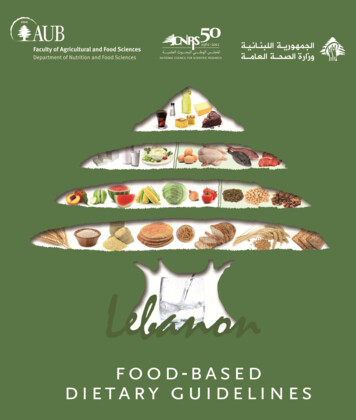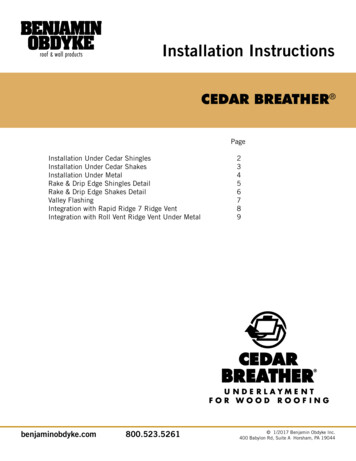
Transcription
the lebanese cedar food guideSolid fats, Oils,Sugar, & Salt(Limit Consumption)Low-Fat Milk & Dairy Products(3 servings per day)Lean Meats,Eggs, Legumes& UnsaltedNuts & Seeds(5 - 6.5 servings per day)Fruit (2 servings per day)& Vegetables(2 - 3 servings per day)Cereals(At least 6 servings per day withat least half of the servings beingwhole grain)Safe Water (around 8 - 12 cups per day)Physical Activity (at least 30 minutes 5 days a week)The cedar food guide at the beginning of this manual provides a graphic illustration of the food groups and the recommended intakes fromeach for Lebanese adults, to ensure a varied and balanced diet providing 2,000 calories (equivalents of a serving of each of the five foodgroups are relayed in Table 3.1 page 16). It also provides a graphic illustration of the recommendations on safe water consumption andengagement in physical activity for improving general health. The recommended intakes from each of the five food groups and the serving1equivalents for each group are adapted from recommendations of the United States Department of Agriculture (USDA MyPlate, 2011).
The Food-Based Dietary Guideline Manual for Promoting Healthy Eatingin the Lebanese Adult Population 2013 by The American University of Beirut.Published by The Faculty of Agricultural and Food Sciences, American University of Beirut,Beirut, Lebanon.All rights reserved.This manual may not be reproduced, stored in a retrieval system, or transmitted in any form or by anymeans, electronic, mechanical, or otherwise, without the prior permission of Dr. Nahla Hwalla, Dean ofthe Faculty of Agricultural and Food Sciences of the American University of Beirut.For permission to reprint excerpts from this publication, please submit a request by email to:nahla@aub.edu.lbISBN: 978 - 9953 - 586 - 00 - 72
acknowledgementsWe thank the Lebanese National Council for Scientific Research (CNRS) for its supportto the Associated Research Unit (ARU) on Undernutrition and Obesity in Lebanonwhich led to the development of this manual. We also thank the Ministry of PublicHealth for adopting this manual and endorsing its dissemination. We would also liketo extend a special thanks to Mrs. Kathryn C. Dorman for her kind editing of the Englishlanguage of this manual.3
contributorsAuthorsNahla Hwalla - PhD, RD. Professor of Human Nutrition and Dean of the Faculty ofAgricultural and Food Sciences, American University of Beirut, LebanonLara Nasreddine - PhD. Assistant Professor of Human Nutrition, Department ofNutrition and Food Sciences, American University of Beirut, LebanonSara Farhat Jarrar - MS. Research Assistant, Department of Nutrition and FoodSciences, American University of Beirut, LebanonGraphic DesignJana Abi Akar, Eweev - Design Agency, Lebanon4
prefaceThis manual has been developed by the Faculty of Agricultural and Food Sciences of the AmericanUniversity of Beirut in collaboration with the Lebanese National Council for Scientific Research(CNRS). This manual has been adopted by the Ministry of Public Health for its disseminationto policy makers, health-care providers, nutritionists, and dietitians in Lebanon. Scientific andofficial institutions look upon this manual as a vital foundation for supporting the nationalnutrition strategy in Lebanon.The guidelines presented in this manual aim at promoting general health, improving dietarybehavior, and reducing the risk of chronic noncommunicable diseases among Lebanese adults.These guidelines are based on simple and easily achievable recommendations based on locallyavailable and affordable foods, for the promotion of healthy eating and lifestyle practices. Theseguidelines can be adopted in various settings, such as in hospitals, private clinics, homes, anduniversities, as well as in health-related businesses.The established recommendations are based on sound scientific evidence relating dietaryand physical activity practices with health outcomes. A thorough review of common chronicdiseases in the country highlighted the prevalence of overweight and obesity, cardiovascular andmetabolic diseases, and micronutrient deficiency-related disorders among the Lebanese adultpopulation. Poor diet and physical activity practices are important factors implicated in theincrease in overweight and obesity in Lebanon, as well as in the emergence of chronic diseasesin the country, including cardiovascular disease, hypertension, dyslipidemia, type 2 diabetes,the metabolic syndrome and certain types of cancer. Moreover, inadequate food intake is alsoimplicated in the development of several micronutrient deficiency-related diseases such asanemia and osteoporosis. The developed Lebanese food-based dietary guidelines have been,therefore, tailored to the food consumption patterns of the Lebanese adult population and theprevalent chronic diseases in the country.The food-based dietary guidelines presented in this manual are not listed in the order of importance.They are integrated recommendations necessitating their implementation as a whole, while beingused in combination with one another for the planning of an overall healthy diet.We hope this manual is able to meet its goal of improving the health of the Lebanese adultpopulation, through guidance towards healthy eating behaviors aimed at preventing thedevelopment of chronic noncommunicable diseases.Nahla HwallaDean of the Faculty of Agriculturaland Food Sciences, AmericanUniversity of BeirutMouin HamzehSecretary General of the NationalCouncil for Scientific ResearchAli Hasan KhalilMinister of Public Health5
table of contentsThe 14 Food-Based Dietary Guidelines for Lebanese Adults1.Enjoy and Maintain a Healthy Body Weight2.Be Physically Active Every Day123.Eat a Variety of Nutritious Foods Every Day for a Balanced Diet144.Eat Cereals, Especially Whole Grains, as the Basis of Daily Meals225.Enjoy More Fruit and Vegetables Daily266.Consume Legume-Based Dishes Regularlyand Enjoy Some Unsalted Nuts and Seeds327.Consume Low-Fat Milk and Dairy Products Every Day368.Consume at Least Two Servings of Fish, Including Fatty Fish, Every Week429.Consume Lean Red Meat and Poultry46Limit Intake of Sugar, Especially Added Sugarfrom Sweetened Foods and Beverages5211 .Limit Intake of Solid Fats and Replace with Vegetable Oils5612 .Limit Intake of Table-Salt and High-Salt Foods6213 .Drink Plenty of Safe Water Every Day6614 .Eat Safe Food7010 .68Conclusion75References76
The 14 Food-Based DietaryGuidelines for Lebanese Adults7
Guideline1Enjoy and Maintain a Healthy Body WeightThe aim of this guideline is to achieve and maintain a healthy body weight, at whichoverall health is improved, while stressing the importance of preventing unhealthyweight gain.Being overweight or obese predisposes an individual to chronic diseases (such ascardiovascular disease, hypertension, type II diabetes, and some types of cancerespecially breast, ovarian, prostate, colon, liver, pancreatic, gallbladder and kidneycancers), while being underweight increases one’s risk of nutrient deficiencies, anemias,bone loss, and early mortality. Individuals who are overweight or obese should aim fordecreasing their body weight, while individuals who are underweight should aim forincreasing their body weight for improved overall health.In Lebanon, overweight and obesity prevalence among adults is estimated at 36.8%and 28.2%, respectively. Obesity is likely to increase in the country, as a trend analysisof two national studies (1997 and 2009) showed a considerable increase in adultobesity prevalence rates by 62%. An emergence of chronic diseases, including diabetesand cardiovascular disease, has paralleled the increasing prevalence of overweight andobesity in the country. Food consumption and lifestyle studies point to an increase inenergy consumption, combined with a low physical activity pattern in the Lebaneseadult population. Faulty dietary habits identified as possible underlying factors includea high intake of fat (especially saturated fat) and sugar, and a suboptimal intake offruit, vegetables, whole-grain cereals, and legumes. Presented below are weightmanagement recommendations for individuals who are overweight and obese (Box1.1) and for individuals who are underweight (Box 1.2). Also presented are importantrecommendations on weight maintenance for special population groups (Box 1.3).88
Box1.1 Aim for a healthy body weight with a normal Body Mass Index (BMI) (refer toTable 1.1)Aim for a slow and steady weight loss (around half a kilogram per week) bydecreasing total energy intake while ensuring an adequate intake of nutrients,and by increasing physical activityBalance calories from foods and beverages with energy expended throughphysical activity (refer to Table 1.2)Pay attention to food portion sizes, as decreasing portion size is one of themost efficient strategies for weight lossLimit the consumption of energy-dense foods, such as Arabic sweets, pastries,and fried foodsLimit the consumption of sugar-sweetened beverages such as sweetened fruitjuices and soft drinks. Opt for fresh fruit juices or non-caloric soft drinks insteadIncrease the consumption of nutrient-dense and fiber-rich foods (such as fruit,vegetables, whole-grains, and legumes)Box1.2 Weight Management Recommendationsfor Overweight and Obese IndividualsWeight Management Recommendationsfor Underweight IndividualsAim for a healthy body weight with a normal Body Mass Index (BMI) (refer toTable 1.1)Balance calories from foods and beverages with energy expended throughphysical activity (refer to Table 1.2)Eat small and frequent meals throughout the dayConsume adequate amounts of food from the different food groups (fruit,vegetables, cereals, legumes, milk and dairy, and meats)Add calories to your day by:- Drinking healthy beverages with a good amount of calories(such as whole milk and fresh fruit juices), in between meals- Munching on nutritious snacks such as fresh or dried fruit,unsalted raw nuts, cereal bars, or yogurt and jamGuideline 1 Enjoy and maintain a healthy body weight9
Weight Classifications According to BMI*Table 1.1BMI (kg/m2)Classification 18.518.5 - 24.925 - 29.9 30UnderweightNormalOverweightObese*The BMI is an indicator of whether your weight is adequate for your height. To calculate your BMI, divide yourweight in kilograms (kg) by your height in meters (m2) squaredNote: : equal to or greater than; : less thanTable1.2Estimated Daily Energy Needs for Weight Maintenance in Adultswith Different Physical Activity Levels*Age Range (years)Energy Range (calories)for MalesEnergy Range (calories)for Females19 - 2021 - 2526 - 3031 - 3536 - 4041 - 4546 - 5051 - 5556 - 60 602,600 - 3,0002,400 - 3,0002,400 - 3,0002,400 - 3,0002,400 - 2,8002,200 -2,8002,200 - 2,8002,200 - 2,8002,200 -2,6002,000 - 2,6002,000 - 2,4002,000 - 2,4001,800 - 2,4001,800 - 2,2001,800- 2,2001,800 - 2,2001,800 - 2,2001,600 - 2,2001,600 - 2,2001,600 - 2,000* The lower end of the energy range corresponds to sedentary individuals while theupper range corresponds to active individualsNote: : greater than10Guideline 1 Enjoy and maintain a healthy body weight
Box 1.3 Important Recommendations for Special Population Groupspregnant womenA woman’s weight at the start of pregnancy is one of the most important modifiers ofweight gain during pregnancy and its impact on the health of the mother and her baby. TheInstitute of Medicine (IOM) in the United States has published new recommendationsfor total and rate of weight gain during pregnancy, based on prepregnancy BMI values(refer to Table 1.3). To ensure proper maternal and child health outcomes, women areadvised to be within a normal BMI range at the time they conceive, and to gain weightwithin the recommended weight ranges shown in Table 1.3.Table1.3Recommendations by the Institute of Medicine for Total WeightGain and the Rate of Weight Gain during PregnancyPrepregnancy BMI(kg/m2)*Underweight:Normal Weight:Overweight:Obese 18.518.5 - 24.925 - 29.9 30Rates of Weight Gain in2nd and 3rd Trimesters**(mean range in kg/wk)Total Weight GainRange (kg)0.45 (0.45 - 0.59)0.45 (0.36 - 0.45)0.27 (0.23 - 0.32)0.23 (0.18 - 0.27)12.7 - 18.211.4 - 15.96.8 - 11.45-9* BMI classified according to the WHO criteria (refer to Table 1.1)** Calculations assume a 0.5 – 2 kg weight gain in the first trimesterNote: : equal to or greater than; : less thanGuideline 1 Enjoy and maintain a healthy body weight11
Guideline2Be Physically Active Every DayThe aim of this guideline is to encourage regular physical activity, as a protectivemeans against overweight, obesity and major chronic diseases.Physical activity is essential for maintaining a healthy body weight and for prevention ofchronic diseases (such as cardiovascular disease, type II diabetes, and certain types ofcancer). Regular physical activity helps increase HDL-cholesterol (the good cholesterol),decrease triglycerides, reduce the need for insulin among diabetics, increase one’smetabolism, and burn fat. Regular physical activity also improves blood circulationand breathing, strengthens bones, muscles and joints, and helps relieve tension andstress. Physical activity can include leisure, occupational, and household activitiesdivided throughout the day with added health benefits. Weight-bearing exercise isalso important, as it can increase bone mineral density and muscle strength, helpingtherefore decrease the risk of osteoporosis and bone fractures. The type of exercisemust, however, be tailored to an individual’s needs and physical abilities.In Lebanon, almost 67.8% of the adult Lebanese population is physically inactive, withmen tending to be less physically active than women. Also, overweight, obesity, chronicdiseases, and osteoporosis are a serious public health concern in Lebanon; stressingthe importance of regular physical activity along with adopting healthy eating habits.Presented below are key recommendations for physical activity (Box 2.1) and tips onhow to be active (Box 2.2)1212
Box2.1 Key Recommendations for Physical ActivityGet moving and be physically active every dayReduce the time spent being physically inactive (such as watching TV, playingvideo games, or sitting at the computer)For weight maintenance, engage in at least 30 minutes of moderate-intensityphysical activity 5 days a week, such as brisk walking, cycling, weight-lifting, ordancing. The 30 minutes of exercise need not be continuous and can be achievedthrough one or a combination of activities throughout the dayFor weight loss, engage in moderate-intensity exercises for greater than 30minutes on most days of the weekFor women above 50 years old, men above 40 years old, pregnant women, andindividuals with a history of chronic disease, consult a healthcare provider beforestarting an exercise regimenBox 2.2Tips How to be ActiveWalk to your destination if possible instead ofdriving your car or taking a cab, and walk brisklyGet off a bus/taxi before your final destinationTake the stairs wherever you areActively play with childrenTake up a new sportGo for a brisk walk 10 minutes before lunchor after dinnerGuideline 2 Be physically active every day13
Guideline3Eat a Variety of Nutritious Foods EveryDay for a Balanced DietThe aim of this guideline is to encourage the consumption of a variety of food itemsevery day, to ensure the diet provides adequate amounts of essential macronutrientsand micronutrients.Diversifying one’s food ensures appropriate intakes of macronutrients (carbohydrates,protein and fat) and micronutrients (vitamins and minerals). Varying one’s food shouldbe interpreted as promoting the consumption of nutrient-dense food items that arerich in vitamins, minerals, phytochemicals, and fiber, rather than unhealthy emptycalories. It is thus important to promote the consumption of nutritious food itemssuch as whole-grains, legumes, fruit, vegetables, fatty fish, and low-fat milk and dairyproducts, while emphasizing the reduction in intake of refined grains, total and solidfats, sweets, and empty calories. Consuming food in moderation by reducing servingsizes is a key point to keep in mind when varying one’s diet.In Lebanon, there is limited data on dietary diversification. However, given theconsiderable progress in food production and processing in the Mediterranean region,there is no doubt that there is access to a constantly increasing variety of fresh andprocessed foods that are now conveniently obtainable on a daily basis. Nevertheless,food consumption data in the country point towards a decreased consumption ofseveral food groups and nutrients, which may explain the observed micronutrientdeficiencies in the country. Inadequate intake of fruit, vegetables, fish, and whole-graincereals has been witnessed in the Lebanese adult population, as well as inadequatedietary intakes of several vitamins and minerals, namely calcium, vitamin D, iron,folate, vitamin B12, potassium, and iodine. Presented below are key recommendationsfor consuming a varied diet (Box 3.1) and tips on how to snack healthy (Box 3.2), aswell as tips on how to achieve the recommended daily intakes of iron and vitamin D(Boxes 3.3 and 3.4). Also presented are important recommendations regarding specificnutrients for special population groups (Box 3.5).1414
Box3.1Key Recommendations for a Varied Diet Stock your kitchen with easy and healthy nutrition. Keep a variety of nutritiousfood items in your kitchen to make meal and snack preparation easy and healthy(such as washed fruit and vegetables, unsalted nuts, low-fat yogurt cheeses, andwhole-grain breads) Choose nutrient-dense food items from each food group for your meals (reviewthe cedar food guide at the beginning of this manual and refer to Table 3.1 forrecommended intakes and serving sizes of each of the five food groups)- Consume whole-grain products as the basis of most meals- Include a variety of legumes and unsalted nuts and seeds in your dailyor weekly diet- Choose a variety of fruit of different colors every day (such as fruit withpits, citrus fruit, berries, and melons) and a variety of vegetables such asdark-green leafy vegetables, orange-colored vegetables, and starchyvegetables- Consume 3 servings of milk per day (low fat or fat free), or consumeequivalent servings of low-fat or fat-free dairy products- Consume fish on a weekly basis, in addition to consuming lean red meatand poultry Choose nutrient-dense food items for healthy snacks throughout the day(refer to Box 3.2)Box 3.2Tips How to Snack HealthySnacking helps boost energy throughout the day. Therefore, plan to snackthroughout the day, while keeping track of the total calories consumed at mealsand snacksPlan your snacks wisely, choosing from nutrient-dense and low fat/low sugaritems like fruit, vegetables, unsalted raw nuts, or low-fat dairy foodsFor those watching their weight, beware of mindless snackingFor those wanting to gain weight, snacking is also recommended as it helpsadd calories throughout the day; choose from nutrient-dense and calorie-richfood items (such as milk-shakes made with fresh fruit or cheese sandwiches withvegetables)Guideline 3 Eat a variety of nutritious foods every day for a balanced diet15
Table3.1Recommended Intakes and Examples of Serving Sizesof Each of the Five Food GroupsRecommended Intakes of theFive Food Groups(based on a 2,000 calorie diet)Cereals and grains(at least 6 servings per day,with at least ½ being wholegrain)Examples of One Serving of Each of the Food Groups ¼ big loaf of Arabic whole-wheat pita bread1 slice of whole-wheat loaf (toast) bread½ cup cooked ‘Burghul’, whole wheat, brownrice, whole-wheat pasta or noodles1 cup ready-to-eat breakfast cereal(unsweetened) 1 small apple1 large banana, orange, or peach½ cup dried fruit (dates, prunes, raisins,apricots)1 cup fresh fruit juiceVegetables(2 - 3 servings per day) 1 cup raw vegetables2 cups raw green leafy vegetables1 cup cooked vegetables1 cup vegetable juiceLow-fat milk and dairyproducts(3 servings per day) 1 cup liquid milk or yogurt3 tablespoons powdered milk45 g white cheese1 cup milk-based pudding such as ‘Mhalbiyeh’,‘Sahlab’ or ‘Riz Bi Halib’8 tablespoons ‘Labneh’Fruit(2 servings per day) Protein-rich foods(5 - 6.5 servings per day) 30 g cooked lean red meat or white meat(poultry or fish)1 whole egg or 1.5 egg whites¼ cup legumes (beans, lentils, peas)15 g unsalted nuts or seedsNote:- The cedar food guide at the beginning of this manual provides a graphic illustration of the above food groupsand the recommended intake of each- The recommended intakes from each of the five food groups and the serving equivalents for each group areadapted from recommendations of the United States Department of Agriculture (USDA MyPlate, 2011)16Guideline 3 Eat a variety of nutritious foods every day for a balanced diet
Box 3.3T i p s How to Achieve the Recommended Daily Intake of IronFor men: 8 mgFor women*: 18 mg Consume lean red meat and poultry; they are rich sources of heme iron, whichis efficiently absorbed by the body. The regular inclusion of these products inthe diet increases the intake of dietary iron (refer to Table 3.2 for other iron-richfood items)Eat more dark-green vegetables (such as broccoli, ‘Mlukhiyeh’, celery, andSwiss chard), and consume legumes (such as lentils, fava beans (‘Fool’), andchickpeas) at least 3 times per week. Make sure to include a source of vitamin C(such as lemon juice or orange juice) or some form of meat with these dishes,because these enhance the absorption of iron from plant-food itemsConsume iron-fortified breakfast cereals if availableAvoid drinking tea, coffee, and caffeine-containing carbonated beverages withmeals, as food components in these beverages may decrease the absorption ofiron in foodDo not take iron supplements, unless otherwise indicated by your physicianor dietitian- Iron supplements are indicated for individuals with iron-deficiency and whenthe diet alone cannot restore iron levels back to normal. Iron supplementsare also recommended for: pregnant women, women of child-bearing age(especially those with heavy menstrual losses), people with renal failure(especially those undergoing routine dialysis), and people with gastrointestinaldisorders who do not absorb iron normally- Iron supplements are not recommended for: individuals who are notexperiencing iron deficiency (especially adult men and postmenopausalwomen) and individuals known to have hemo-chromatosis (a genetic diseasecharacterized by iron overload)- Daily maximum limit for iron intake: 45 mg* Iron requirements decrease to 8 mg/day for women after the age of 50 years, considered the onset ofmenopauseNote: Spinach is not a rich source of iron. Iron in spinach is not well absorbed by the body due to othercompounds present that interfere with its absorptionGuideline 3 Eat a variety of nutritious foods every day for a balanced diet17
Table3.2Iron-Rich Food ItemsFood ItemOrgan meat, cooked (90 g*)Cereals, iron fortified (¾ cup)Soybeans, boiled (½ cup)Pumpkin seeds, roasted (30 g**)Carob molasses, 1 tablespoon (15 ml)Lentils, cooked (½ cup)Beef, tenderloin, cooked (90 g)Kidney beans, cooked (½ cup)Sardines, canned in oil, drained (1 can)Lima*** beans, boiled (½ cup)Pinto† beans, boiled (½ cup)Raisins, seedless (½ cup)Chicken thigh, cooked (105 g)Chicken breast, cooked (½ breast, 90 g)Iron(mg)5.2 - 9.94.54.44.23.53.332.62.52.31.81.51.31.1*90 g equals in size a deck of playing cards or the palm of a hand**30g 2 tablespoons***Lima beans: ‘Fasoulia Aa’reeda’†Pinto beans: ‘Fasoulia Aysha Khanum’Note: Legumes and other iron-containing plant foods shouldbe consumed with a vitamin-C rich food source, or with smallamounts of meat, chicken, or fish, for better absorption of iron18Guideline 3 Eat a variety of nutritious foods every day for a balanced diet
Box 3.4TipsHow to Achieve the Recommended Daily Intakeof Vitamin DFor individuals 20 - 70 years: 600 IU*For individuals aged 70 years or older: 800 IU Consume a variety of fish and seafood (refer to Table 3.3 for other vitamin-Drich food items)Consume vitamin D-fortified food products (such as breakfast cereals andmilk) if availableConsider taking a daily low-dose vitamin D supplement (providing 200 IU or400 IU) after consulting with your physician or dietitian- As there is a potential for vitamin D toxicity from too much vitamin Dsupplement use, the following individuals should avoid taking vitamin Dsupplements: individuals who are not vitamin D deficient, those who areexposed to plenty of sunlight, and those who consume a vitamin D-rich diet- Daily maximum limit for vitamin D intake: 4,000 IUAttention:. Although the sun is important for vitamin D synthesis by the skin, it is advised to limit one’ssun exposure due to risk of skin cancer. Using sunscreens of SPF greater than 15 can limit the skin’s ability of synthesizing vitamin D* IU International UnitsTable3.3Vitamin D-Rich Food ItemsFood ItemVitamin D(IU)Cod liver oil, 1 tablespoon (15 ml)Salmon, cooked (100 g)Tuna, canned in oil (½ can)Sardines, canned in oil (½ can)Tuna, light, canned in water (½ can)Milk, vitamin-D fortified (1 cup)Egg, wholeBeef liver, cooked (100 g)1,360360200250154982015Note:100 g equals in size to slightly more than the size of a deckof playing cards or the palm of a hand1 cup 240 mlGuideline 3 Eat a variety of nutritious foods every day for a balanced diet19
Box 3.5 Important Recommendations for Special Population Groupsvegetarians Vegetarians should include a varietyof plant-based protein sources suchas legumes and nuts to ensure anadequate intake of iron and proteinVegetarians are advised to increasethe bioavailability of iron from plantsources by adding vitamin C-rich fooditems (such as lemon or orange juice,kiwi, and green peppers) to mealsStrict vegetarians (vegans) mustconsume vitamin D and vitamin B12enriched food items (refer to Tables3.3 and 3.4) to meet the recommendeddaily intakes of vitamin D (600 IU)and vitamin B12 (2.5 microgram [µ g] )women ofchild-bearing age 20Folate is an important vitamin for womenof child-bearing age, as it is necessary forreducing the risk of anemia and certainfetal malformations (such as neural tubedefects) during pregnancyWomen of child-bearing age are advisedto consume folate-rich food items(refer to Table 3.5), especially greenleafy vegetables, fruit, beans, and peas.Before and during pregnancy, a dailyintake of 600 µg of folate is required.It is thus recommended to take a folicacid supplement providing 400 µg/dayalongside consuming a folate-rich dietone month before pregnancy and duringthe 1st three months of pregnancyGuideline 3 Eat a variety of nutritious foods every day for a balanced diet
Table3.4Vitamin B12-Rich Food ItemsFood ItemMollusks, cooked (90 g)Beef liver, braised (1 slice)Salmon, cooked (90 g)Lean beef, broiled (90 g)Yogurt (1 cup)White tuna, canned in water (½ can)Milk (1 cup)Egg, hardboiled (1 whole)Chicken breast, roasted (½ breast, 90 g)VitaminB12 (µg)84.147.94.92.41.410.90.60.3Note:90 g meat equals in size a deck of playing cardsor the palm of a hand1 cup 240 mlTable3.5Folate-Rich Food ItemsFood ItemFolate(µg)Beef liver, braised (90 g)Spinach, frozen, boiled (½ cup)Asparagus, boiled (4 spears)Spinach, raw (1 cup)Green peas, frozen, boiled (½ cup)Broccoli, frozen, cooked (½ cup)Lettuce, Romaine, shredded (½ cup)Cantaloupe (¼ medium)Banana (1 medium)18510085605050402520Note:90 g meat equals in size a deck of playing cards or thepalm of a handGuideline 3 Eat a variety of nutritious foods every day for a balanced diet21
Guideline4Eat Cereals, Especially Whole Grains,as the Basis of Daily MealsThe aim of this guideline is to emphasize the importance of consuming a variety ofcereals every day, particularly whole-grain cereals which are rich in dietary fiber.The consumption of cereals, especially whole grains, has been associated witha decreased risk of cardiovascular diseases, overweight, abdominal obesity,hypercholesterolemia, and insulin resistance. Higher intakes of breads and cereals canhelp in achieving dietary targets of lower fat consumption, and as cereals are a majorsource of resistant starch, they are an important dietary component for colon health.The Food and Drug Administration (FDA) in the United States has approved the healthclaim that ‘diets rich in whole-grain foods and other plant foods, and low in total fat,saturated fat, and cholesterol may reduce the risk of heart disease and certain cancers’.In Lebanon, although there has been a consistent decline in cereal consumptionover the past three decades, cereals remain the principal staple food in the country.Cereals and cereal-based products contribute to almost ⅓ of daily energy intakeamong the Lebanese adult population, with wheat (mainly consumed as bread) beingthe major staple cereal, followed by rice. Nevertheless, a trend towards an increasedconsumption of refined cereals such as refined flour and pasta, as well as white rice,at the expense of whole-grain cereals has been witnessed. In a country where chronicdiseases are prevalent, the consumption of cereals, especially whole grains, as the basisof most meals, will help play a role in reducing the risk of chronic diseases (includingcardiovascular disease, type II diabetes, and certain types of cancer such as colon andbreast cancer), in addition to promoting colon health and helping maintain normalbody weight. Presented below is the recommended daily intake of cereals (Box 4.1), aswell as key recommendations and tips for cereal and whole-grain cereal consumption(Box 4.2).2222
Box4.1Recommended Daily Intake of Cereals(based on a 2,000 calorie diet)At least 6 servings per day, with at least half ofthe servings being whole-grain cereals1 serving is equal to:¼ loaf of Arabic pita bread1 slice of loaf (toast) bread½ cup cooked ‘Burghul’, wheat, rice, spaghetti,noodles, or macaroni 1 cup ready-to
Increase the consumption of nutrient-dense and fiber-rich foods (such as fruit, vegetables, whole-grains, and legumes) Aim for a healthy body weight with a normal Body Mass Index (BMI) (refer to Table 1.1) Balance calories from foods and beverages with energy expended through physical activity (refer to Table 1.2)










